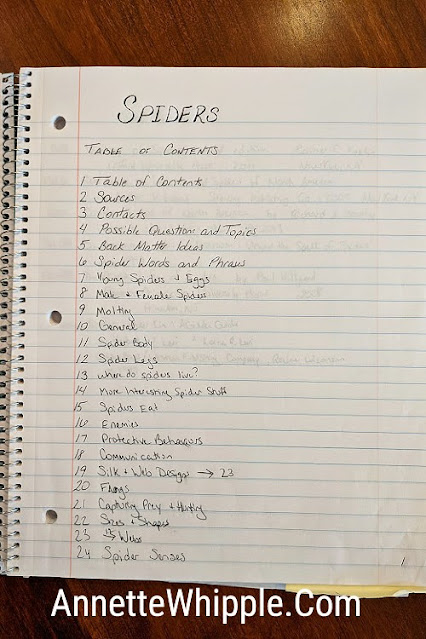When I teach about nonfiction, there are so many questions about research. Workshop attendees love seeing my research notebooks in action. So I took some pictures to share a bit with you. (Actually, I share more than a bit. I hope it's all helpful!)
I prefer cheap notebooks for most of my smaller research and writing projects. Professional writers (both fiction and nonfiction authors) and students of all ages can use research notebooks effectively. I want to share how I set one up so you can duplicate the process if it interests you.
Before I go on, I must state that my research goes beyond the notes I take in my notebook even for smaller projects. (It has to for professional writing.) I also have folders filled with printed articles, interviews, and more. I have digital files on my computer as well. For some projects, 3-ring binders serve me better than spiral notebooks. For my book The Laura Ingalls Wilder Companion, I dedicated an entire file organizer to my research. I used a couple of five-subject notebooks in addition to my file organizer and digital files. Honestly, I prefer the portability of my notebooks, but a few 3-ring binders would have been a better choice for that book. Of course, student writers and fiction writers might not need such extensive research.
I can limit my note-taking to one spiral notebook for short projects when I know in advance what the project will look like such as the books in The Truth About series with Reycraft Books once the first book's structure was established. If I already have my story organized, and possibly the structure selected, then my hand-written notes likely fit in a a single spiral notebook! Of course, I still need to utilize digital and paper folders, but my research notebook gets me started.
Getting Started with a Research Project
For my book Scurry! The Truth About Spiders, I began by brainstorming about spiders. I previously shared how I used the bubble brainstorming method (and the trick to make it work for me). From there, I grouped ideas together. I made a big list of possible topics. Then, I set up my research notebook.
It isn't necessary to brainstorm your research topic before beginning, but I find it helps me.
The Table of Contents in a Research Notebook
On the very first page of my notebook, I create a Table of Contents. At the top of the page I place the topic and label the page "Table of Contents." Then I write numbers 1-25 (depending on the number of lines) going down the page on the left-hand side.
I add additional topics and numbers to the back side of this first page in my research notebook as needed. I prefer to begin with just numbering the front of page 1.
Number the Pages in a Research Notebook
Each of those numbers in the Table of Contents corresponds to a page number in the book. For simplicity, I number each sheet of paper, but only the pages on the right (and at the bottom). I do not number the back of the pages. (I do write on them though.)
I typically begin by numbering just the first 25 or so pages in the notebook. I add more page numbers as I add notes.
Don't Forget These in a Research Notebook
My research notebooks generally include a few topics for notetaking. The Table of Contents makes it easy to find the proper page to write information--and later use it for writing. But that's not all that's important.
Sources
Right after the Table of Contents, I label the next page as "Sources." Here I list the books, journals, interviews, articles, websites, and any other source for my research. I include all the information I would need for a formal bibliography, but here I don't worry about the order I write everything. I also create a formal bibliography online with a site such as EasyBib.com.
Then I give each source a nickname. For the source, Biology of Spiders, by Rainer F. Foelix, my code name was BIO. I learned this research/citing research tip from Nancy I. Sanders who shares a ton of information for writers. I typically use the tile of the article, journal, or book to come up with the nickname, but Nancy uses the name of the author which has its advantages.
Later when I take a note from this source, I simply add BIO88 as my reference in my notes. That means the information I found was in Biology of Spiders on page 88. I can also footnote my sources in the same manner in my manuscript. (If I outline my manuscript, I actually prefer to footnote my outline instead of the manuscript for short manuscripts.)
Contacts
On the next page in each of my research notebooks, I dedicate a page to contacts. You can include as much information as you like, but I include the name, preferred method of contact (which is typically email, but not always), and their affiliation (such as a university, museum, or professional organization).
With some of my research notebooks, I also include hopeful contacts--the names of experts on the topic I hope to contact and learn from.
For Scurry! The Truth About Spiders, I was in touch with two spider experts. One I contacted through the American Arachnology Society. He had 65 years of hands-on spider experience! The other was a local expert who I found through a mutual friend. They were both incredibly helpful! I find it's to my advantage to work with multiple experts especially for longer books like The Laura Ingalls Wilder Companion. (affiliate link)
Students may or may not consult experts. They might skip including a list of contacts in their research notebook.
Possible Ideas
Next I tend to include a list of possible questions to address, topics to cover, and ideas to include. I use my brainstorming to help me compile the ideas.
Back Matter Ideas
I love back matter. For those unfamiliar with the term, back matter is the additional information that comes after the main story is over in a book. Back matter is important in both fiction and nonfiction books for ALL ages. Since I write science and history for kids, I like to include a hands-on activity in addition to more facts.
Scurry! The Truth About Spiders included six pages of additional spider information after the main text. In my research notebook, the page devoted to Back Matter Ideas was just that--ideas. I didn't actually take notes there. Here you can see a bit of the back matter in Scurry.
Words and Phrases
Another item I include in my research notebooks before the topical notes is a list of words and phrases related to the topic. I included terms like ambush and scuttle in my list about spiders.
Research in the Research Notebook
Once I've included my typical headings, I use my handy-dandy list of possible topics to help me include specific headings to each page in my research notebook. I prefer to be as specific as possible. What were my headings? Take a quick look at the Table of Contents image (above) to see.
So in addition to Spider Body, I also had headings titled Spider Legs, Fangs, and Spider Senses. All related, right? I also titled one page Enemies and another Protective Behaviors. Similar but different, right? I made the mistake of not separating the topics of silk and web design, so I used multiple pages for those related topics instead of just the front and back of a sheet.
Lots of my notes made it into the book. Take a look at Scurry! The Truth About Spiders. (affiliate)
How do you keep track of your research? How do your students take notes? I'd love to hear about your research notebooks, online sources, notecards, and more! Will you be able to use any of my tips? Don't forget to check out my post about brainstorming for nonfiction writing!



















For the most part, your system is like mine. One thing I've added is that I keep a list of revisions on the last page of the spiral that includes number, date, major change, and if I shared with anyone for feedback. Wonderful post!
ReplyDeleteOOO! That's a good idea. I do go into my outline (where I have footnotes) to add revisions with sources. (I learned that the hard way.) :) I like the idea of adding it to the spiral!
DeleteAnnette this is such a thorough, detailed and very helpful presentation of your research process. I have just joined this group because there really aren't many books about writing nonfiction and I knew I needed something more in-depth. I will definitely sign up for your newsletter. Thank you for this article.
ReplyDeleteTerry Northcutt
Terry, thank you for your encouragement! It's a blog post that I'd been wanting to write for months...but knew it wouldn't be a quickie. :) Best of luck to you as you dive into writing more nonfiction! Use KIDLIT25 for a 25% discount if you're interested in my video NF course.
DeleteAnnette, I picked up several tips in this blog post, but especially love your nicknames/codes for various references! Congrats on your various books!
ReplyDeleteThanks so much, Josette! Happy writing!
DeleteThanks so much Annette for taking the time to write all of this down!
ReplyDeleteAnnette, I love this post! As a fellow nonfiction KidLit writer, I love seeing an up close and personal look at your research process. You are amazing!!!!
ReplyDeleteThanks so much, Nancy! You and I are always learning...even from one another!
DeleteGreat post, Annette! Very informative and thorough. Thank you. :)
ReplyDeleteYou're so welcome, Kathy!
DeleteThank you Annette! I am planning a non-fiction for my next book, and I definitely am finding these ideas helpful. I had started the book a couple years ago, but I really lacked the organization and knowledge to go forward with it. This helps me feel like I should pick up my pencil and give it a try again.
ReplyDeleteThanks so much, Brittany! Probably the most important tip isn't related to research...but to have FUN with your book! Happy writing!
DeleteOh, if you're interested in my NF video course, use KIDLIT25 for 25% discount!
Love the tips. You are definitely more organized than me when it comes to research. On the other hand, I did start a writing journal to record my thoughts/feelings about my writing projects. At first I wondered if I should be using up my precious writing time to journal, but I've found it to be extremely valuable. Helps me focus and keep track of what I need to work on next. Now, adding your tips to my writing journal. :-)
ReplyDeleteHave fun with this! Reflection is an important part of writing...I need to do more of THAT!
DeleteAwesome post and great tips and techniques! I see why you are so successful!
ReplyDeleteThanks so much, Mindy! Now if only I could get my desk to be organized like a simple notebook and folder!
DeleteOooh! Thanks for this notebook idea and the details! Pull out the spiral notebooks.
ReplyDelete